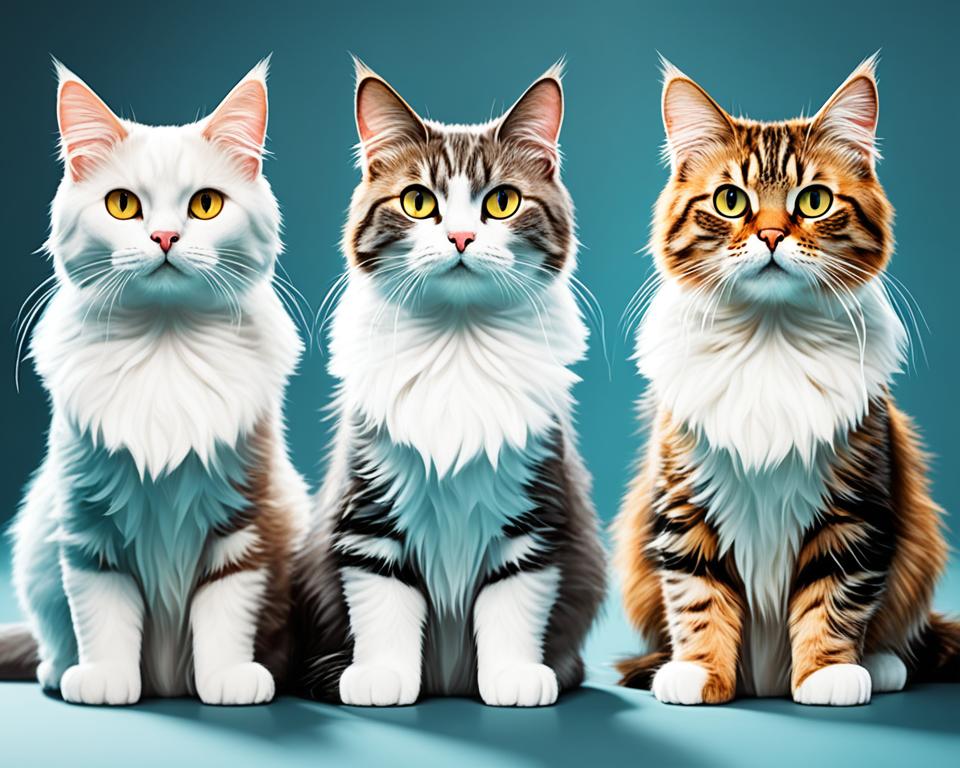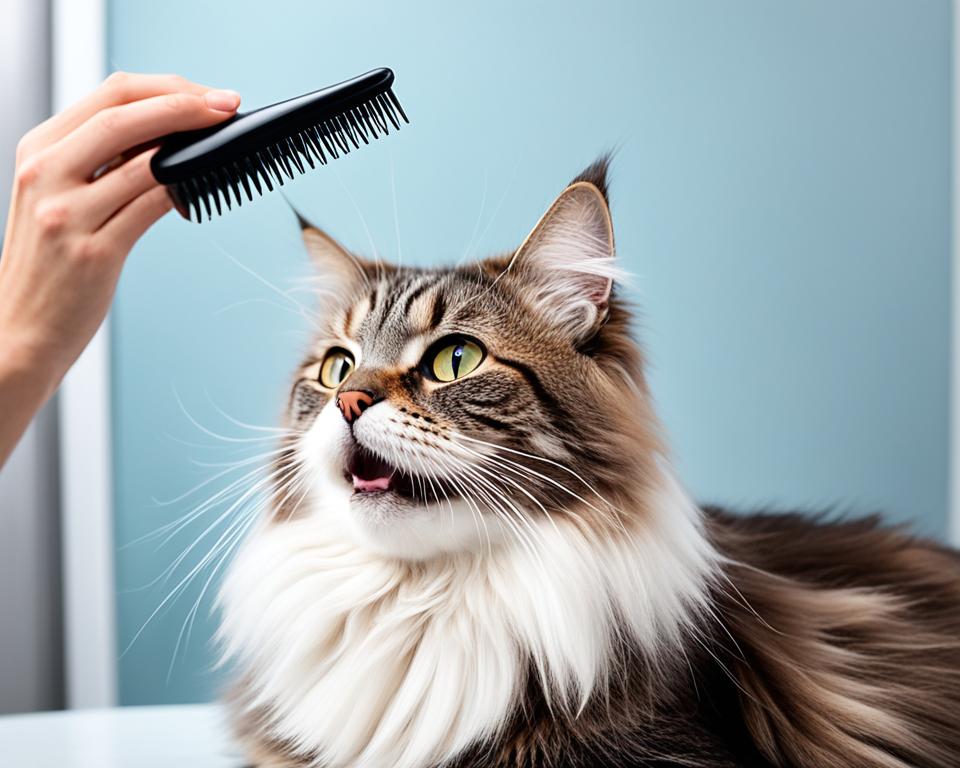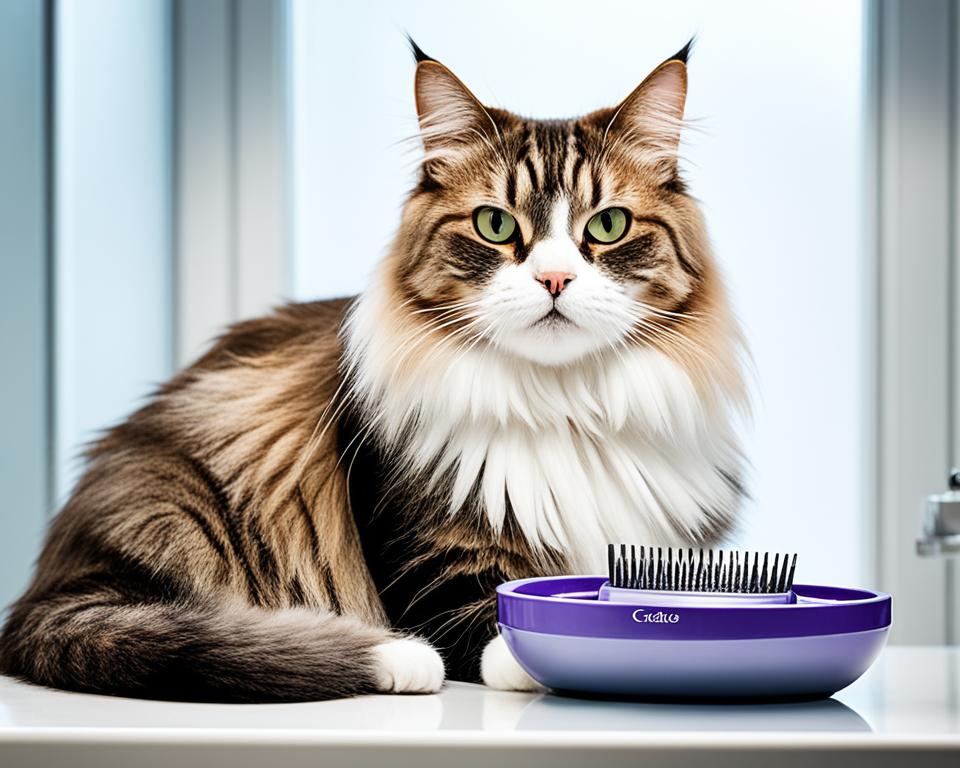Being a cat owner means more than just keeping my furry friend looking good. It’s key to their health and happiness. Regular grooming keeps their coat healthy and helps us bond.
Brushing my cat once or twice a week stops mats and skin issues. This simple act is vital for my cat’s health and happiness. Regular grooming makes a big difference in their well-being.
Every cat is different in what they need for grooming. Long-haired cats need more care than short-haired ones. But all cats do well with regular brushing, nail trimming, and dental care.
By focusing on grooming, I keep my pet looking great and check for health issues. This early action keeps my cat happy and healthy for a long time.
Understanding Your Cat’s Coat

Cats have many coat types, each needing different care. Knowing these differences helps keep your cat healthy and happy. Let’s look at the main coat types and what they need.
Long-haired Cats
Long-haired cats have beautiful coats. They need daily grooming to avoid mats and tangles. A wide-toothed metal comb is best for these areas.
Brushing them regularly spreads natural oils and keeps their coat shiny.
Short-haired Cats
Short-haired cats have coats that are easy to care for. They don’t need as much grooming as long-haired cats. But, brushing them once a week is good.
This removes loose hair and dirt, keeping their coat healthy. It also cuts down on shedding at home.
Hairless Cats
Hairless cats, like the Sphynx, need special care. They don’t have fur to absorb oils, so they need more baths. Use gentle, cat-specific shampoos for these sensitive cats.
| Coat Type | Grooming Frequency | Special Needs |
|---|---|---|
| Long-haired | Daily | Detangling, mat prevention |
| Short-haired | Weekly | Shedding control |
| Hairless | Weekly baths | Oil control, skin protection |
Grooming is more than making your cat look good. It’s a way to connect with them and check for health issues. Cats change as they age, so watch for these changes and adjust your grooming.
“Grooming is not just a beauty routine; it’s a vital part of your cat’s health and well-being.”
Essential Grooming Tools for Cats

Having the right tools for grooming your cat makes a big difference. It keeps them looking and feeling great. Let’s look at some key supplies every cat owner should have.
Brushes and Combs
Cat brushes vary for different coats. For long-haired cats, metal combs are best for untangling. Short-haired cats do well with rubber brushes to remove fur and help the skin.
Nail Clippers
Trimming your cat’s nails is key. I choose cat-specific clippers for safety and the right fit. It’s vital to avoid the quick to prevent pain and bleeding. Always have styptic powder ready.
Ear Cleaning Supplies
Ear care is crucial for cats. I use a soft ear cleaner and cotton balls to keep ears clean and healthy. Regular cleaning stops wax buildup and catches problems early.
Quality grooming tools are worth it. They last longer and work better, making grooming easier for you and your cat. With these supplies, you’ll keep your cat looking great!
Cat Grooming: The Basics and Benefits
Cat grooming is key for their health and hygiene. Regular grooming has many benefits for cats. It keeps them looking good and healthy.
Brushing your cat often spreads natural oils, removes dead hair, and boosts blood flow. This can make their coat healthier and cut down on shedding. It’s also a chance to spot any skin problems or lumps.
| Grooming Task | Frequency | Benefits |
|---|---|---|
| Brushing | 1-7 times per week | Reduces shedding, prevents matting |
| Nail Trimming | Every 2-4 weeks | Prevents discomfort, scratching issues |
| Ear Cleaning | As needed | Prevents ear infections |
| Dental Care | 2-3 times per week | Maintains oral health |
| Bathing | Rarely, as needed | Removes dirt, improves coat condition |
Starting a grooming routine helps cats get used to it and lowers stress. Cats spend almost half their awake time grooming. This shows how crucial grooming is to them.
Each cat’s coat type needs different care. Short-haired cats might need brushing once a week. Long-haired cats often need daily brushing to avoid mats. Adding these steps to your routine shows the value of grooming for cats.
Brushing Techniques for Different Coat Types

Brushing your cat is more than just keeping them clean. It’s a way to bond and keep them healthy and happy. Different coats need special brushing techniques to look their best.
Brushing Short-haired Cats
Short-haired cats are easy to care for but still need regular grooming. I brush them with a rubber mitt or a bristle brush once a week. This removes loose fur and helps their skin stay healthy. Focus on areas that shed a lot like the back and belly.
Brushing Long-haired Cats
Grooming long-haired cats takes more work and is done daily. I use a slicker brush and a wide-tooth comb. Start at the belly and legs, then move up to the head. This stops mats and spreads natural oils in their coat.
Dealing with Matted Fur
Matted fur can be painful for your cat. If you find knots, sprinkle some talcum powder and gently work them out. For tough mats, you might need a mat-splitter. Always try to prevent mats before they start.
| Coat Type | Brushing Frequency | Recommended Tools |
|---|---|---|
| Short-haired | Weekly | Rubber mitt, Bristle brush |
| Medium-haired | 2-3 times a week | Slicker brush, Wide-tooth comb |
| Long-haired | Daily | Slicker brush, Wide-tooth comb, Mat-splitter |
Brushing your cat often keeps their coat shiny and reduces shedding and hairballs. It’s good for both you and your cat!
Bathing Your Cat: When and How
Cats don’t like water, right? But sometimes, a bath is needed. Let’s look at when and how to bathe your cat for good hygiene.
Not all cats need regular baths. Healthy adult cats usually clean themselves. But some cats need baths:
- Hairless breeds need baths to remove excess skin oils
- Long-haired cats may struggle with self-grooming
- Senior cats (8+ years) might need help due to mobility issues
- Overweight cats often can’t reach all areas effectively
- Cats with skin conditions may require medicated baths
Prep is important before a bath. Get cat-specific shampoo, towels, and a non-slip mat. Put cotton in your cat’s ears to keep water out. Use lukewarm water and skip the face, ears, and eyes. Rinse well to avoid skin irritation.
After the bath, dry your cat in a warm spot. Long-haired cats need extra care to avoid mats. Treats and praise make bathing a good experience.
“A clean cat is a happy cat, but only bathe when necessary to maintain the natural oils in their coat and skin.”
Knowing when and how to bathe your cat keeps them clean and happy. Every cat is different, so adjust your approach to fit your pet’s needs and personality.
Nail Care and Trimming
Cat nail trimming is key for pet nail care. Regular clipping of cat claws keeps cats happy and healthy. Let’s look at how to keep your cat’s nails in check.
Choosing the Right Nail Clippers
Choosing the right tool is key for trimming cat nails. There are three main types of clippers for cats:
- Scissors-style clippers
- Guillotine-style clippers
- Pliers-style clippers
I like scissors-style clippers for their precision and ease. Nail grinders can smooth out rough edges, but some cats don’t like the noise.
Step-by-Step Nail Trimming Guide
Here’s a simple guide for clipping cat claws:
- Gently hold your cat’s paw and press the pad to extend the claw
- Identify the quick (pink area inside the claw)
- Trim only the tip at a 45-degree angle
- Repeat for each claw, taking breaks if needed
I suggest trimming every 1.5 to 2 weeks for indoor cats. Kittens might need weekly trims, while older cats may only need monthly attention.
Dealing with Reluctant Cats
Some cats don’t like nail trimming. Here are some tips:
- Start with short sessions
- Use positive reinforcement with treats or toys
- Watch for signs of stress like tail twitching or growling
- Consider professional help if difficulties persist
Remember, clipping cat claws is safer than declawing, which the ASPCA doesn’t recommend. With patience and practice, nail care can be a bonding experience for you and your cat.
Dental Hygiene for Cats
Cat dental care is super important for our feline friends. Did you know 50% of cats have periodontal disease? For cats over 3 years, it’s 75%. So, keeping their teeth clean is a must for every cat owner.
Brushing cat teeth might seem hard, but it’s key to prevent big health issues. Bad dental health can affect the heart, liver, and kidneys. Start with a toothbrush made for cats and toothpaste too. Don’t use human toothpaste, as it can make your cat sick. Choose toothpastes with flavors like poultry or malt instead.
To keep your cat’s teeth clean, brush in circular motions at the gum line. Begin with short sessions and add more time as your cat gets used to it. Brushing once a week can really help your cat’s teeth. Remember, plaque can come back in just six hours, so regular brushing is important. If you’re not sure how to brush, ask your vet to show you during your cat’s check-up.

